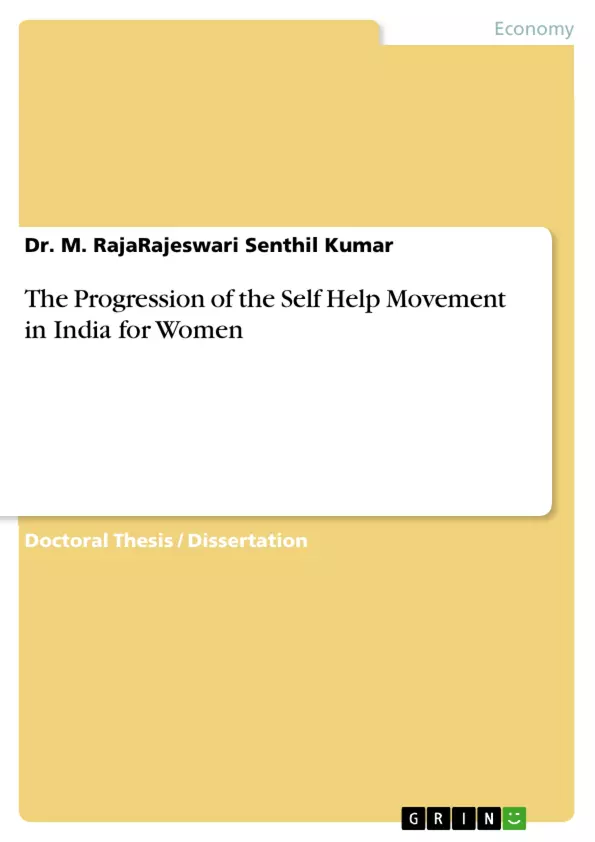The key aspect of the present research is to identify the preliminary respondents through an interview with a few selected leaders and members. Further, a study has been conducted and the data have been collected from 50 SHG leaders and 150 SHG members and the results of the survey have necessitated certain changes for the final structuring of the interview schedule meant for the SHG leaders (500 Nos.) and SHG Members (1500 Nos.) chosen for the study Ever since Independence a number of innovative schemes have been launched for the upliftment of women in our country.
Indian Government has taken lot of initiatives to strengthen the institutional rural credit system and development programmes. Viewing it in the welfare programmes of Ninth Five Year Plan (1997-2002) and shifting the concept of Development to Empowerment. The Indian Government adopted the approach of Self Help Groups (SHGs) to uplift the rural women. The empowerment of women through Self Help Groups (SHGs) would lead to benefits not only to the individual woman and women groups but also the families and community as a whole through collective action for development. This book will be highly useful to students of social studies especially Women Studies, Social Work, Sociology, Economics and also to the students and research scholars specialising in Human Development and NGOs and also other functionaries dealing with women..
After independence, India has been adopting aggressive national economic development plans through various public policies and the policy makers have been emphasizing upon the need of national development ever since the advent of planning process in the country. The ultimate objective of national development is eradication of poverty and improving the quality of masses. In India, there has been an aggressive effort on the part of the Government, concerned with improving the access of the poor to formal credit system through implementation of focused programmes for removal of poverty and thereby aiming economic fortification.
Table of Contents
- OVERVIEW ON SELF-HELP MOVEMENT
- SAMPLING DESIGN AND METHODOLOGY
- REVIEWS
- SELF-HELP GROUPS CONTOUR
- DEMOGRAPHIC PROFILE – SELF-HELP GROUPS CONTOUR
- DEMOGRAPHIC PROFILE – LEADERS/ANIMATORS PERSONAL PROFILE
- FUNCTIONAL PATTERN OF SHGS - LEVEL OF AWARENESS AND KNOWLEDGE
- FUNCTIONAL PATTERN OF SHGS - GENERAL FUNCTIONING SPECTRUM
- FUNCTIONAL PATTERN OF SHGS: RECORD KEEPING - [MAINTENANCE OF RECORDS]
- FUNCTIONAL PATTERN OF SHGS: RECORD KEEPING - [FREQUENCY OF INVESTIGATION OF RECORDS]
- ECONOMIC ACTIVITIES OF SELF-HELP GROUPS
- ECONOMIC ACTIVITIES - BUSINESS PROFILE
- PROBLEMS IN BUSINESS OPERATIONS
- ECONOMIC ACTIVITIES: BUSINESS FEASIBILITY - [MARKETING AND TRAINING ACTIVITIES]
- ECONOMIC ACTIVITIES: BUSINESS FEASIBILITY - [MARKETING PROBLEMS]
- BUSINESS PROFILE AND BUSINESS FEASIBILITY
- SELF-HELP GROUP MEMBERS CONTOUR
- SOCIO-DEMOGRAPHIC PROFILE OF SHG MEMBERS
- ECONOMIC-DEMOGRAPHIC PROFILE OF SHG MEMBERS
- FUNCTIONAL PATTERN - REASONS TO PERSISTENCE
- FUNCTIONAL PATTERN: REASONS TO PERSISTENCE - [KNOWLEDGE OF BANK OPERATIONS]
- FUNCTIONAL PATTERN -CONSTRUCTIVE EFFECT OF GROUP PARTICIPATION
- STAGE 1 - FUNCTIONAL PATTERN - BENEFITS ENJOYED BEING A MEMBER
- STAGE 11-FUNCTIONAL PATTERN - BENEFITS ENJOYED BEING A MEMBER
- ECONOMIC ACTIVITIES OF SELF-HELP GROUP MEMBERS
- ECONOMIC ACTIVITY - BUSINESS PROFILE OF SHG MEMBERS
- BUSINESS FEASIBILITY - OPINION ON OPTING THE BUSINESS
- BUSINESS FEASIBILITY - PROBLEMS FACED BY SHG MEMBERS
- RELATIONSHIP BETWEEN BUSINESS PROFILE AND BUSINESS FEASIBILITY
Objectives and Key Themes
This book aims to provide a comprehensive analysis of the Self-Help Group (SHG) movement in India, particularly focusing on its impact on the economic progression of rural women. It examines the effectiveness of SHGs in empowering women and promoting their economic development, while also exploring the challenges and opportunities associated with this movement.
- The role of Self-Help Groups (SHGs) in empowering rural women and promoting their economic development.
- The effectiveness of the SHG movement in addressing the needs of rural women and improving their livelihoods.
- The challenges and opportunities faced by SHGs in India, including access to credit, market linkages, and capacity building.
- The impact of SHGs on the social, economic, and political empowerment of women.
- The importance of government policy and support in strengthening the SHG movement in India.
Chapter Summaries
The book begins by providing an overview of the Self-Help Movement in India, tracing its origins and evolution. It then delves into the research methodology employed for the study, outlining the sampling design and data collection techniques. Chapter 3 offers a review of existing literature on the topic of SHGs, providing a framework for understanding the key concepts and debates surrounding the movement.
Chapter 4 focuses on the contour of Self-Help Groups, examining their demographic profile, leadership structures, and functional patterns. This chapter analyzes the level of awareness and knowledge among SHG members, as well as the factors influencing their general functioning and record-keeping practices.
Chapter 5 explores the economic activities undertaken by Self-Help Groups, analyzing their business profiles, the problems they encounter in their operations, and the feasibility of their business ventures. The chapter also examines marketing and training activities conducted by SHGs, as well as the marketing problems they face.
Chapter 6 provides an in-depth analysis of the socio-demographic and economic-demographic profiles of SHG members. It investigates the reasons for their persistence in the movement, their knowledge of bank operations, and the constructive effects of their group participation. The chapter further examines the benefits they have enjoyed as members, both in the initial stage and later stages of their involvement in SHGs.
Keywords
This book is primarily focused on the economic progression of rural women through Self-Help Groups (SHGs) in India. Key terms and concepts explored include rural empowerment, women's development, microfinance, credit access, social capital, collective action, poverty alleviation, and institutional support. The study delves into the socio-economic and functional characteristics of SHGs, their impact on member livelihoods, and the challenges they face in achieving their objectives.
- Quote paper
- Dr. M. RajaRajeswari Senthil Kumar (Author), 2016, The Progression of the Self Help Movement in India for Women, Munich, GRIN Verlag, https://www.grin.com/document/371217



